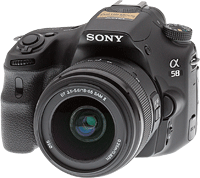Sony A58 review: Stellar image quality just one reason we think the A58 ranks among the best DSLRs for beginners
posted Friday, August 16, 2013 at 9:46 AM EDT

In creating its entry-level Sony A58 DSLR, the consumer electronics giant took its well-regarded predecessor, the A57, added some significant tech upgrades -- most notably its new 20.1-megapixel APS-C sensor -- and then made just a few compromises to deliver the new model at a $200 lower price point. By doing so, the A58 effectively replaces not just the mid-entry-level A57 but also the true-entry-level A37. But does the camera split the difference and sit somewhere in the middle of these two cameras, or does it outshine them both?
Well, in terms of image quality, it's clear that the Sony A58 has taken a huge step forward. The higher-resolution sensor helps it deliver stunning photo quality that's sharper and more detailed than that of its predecessors. In fact, the A58's JPEG images stack up well against those from much more expensive, enthusiast-level DSLRs. You can even get excellent 30 x 40 inch prints at ISO 100 and 200 from the camera, a finding that truly surprised us. Other big steps forward include a bright, clear 1.44M-dot Organic LED viewfinder, the addition of Sony's proprietary Multi Interface hot shoe, and improved battery life.
Otherwise, the A58 borrows a lot of its tech from the A57, including the 15-point continuous AF system (with three cross-type points) which allows the DSLR to autofocus quite quickly and accurately in most situations. The physical design and size of the two cameras remain roughly the same, as does the control layout -- except for a few changes.
One of the biggest changes, however, is that the A58 uses a plastic lens mount rather than a metal one. And while people may be turned off by this -- with the fear that the material may be flimsier and more breakable -- it must be noted that many manufacturers successfully employ plastic mounts on lenses these days. It's a calculated risk on Sony's part, and we're going to give them the benefit of the doubt on this one until we see how the A58's plastic mount lasts over time.
Other sacrifices made on the A58 include the lack of a 60p frame rate while recording Full HD movies, as was available on the A57. Despite that, the A58 still is a very good movie maker, offering 60i/24p frame rates and overall video quality that surpasses most of its entry-level rivals. The increased 20.1-megapixel resolution on the new model also has a downside, as the same BIONZ processor as on the A57 now only delivers a five frames per second max speed in continuous burst mode, and the image buffer is also correspondingly more shallow.
It's a challenge to weigh the pros and cons of the Sony A58, but we're clear where we stand on it. Read our in-depth Sony A58 review to find out! In addition to a thorough shooter's report, you can also read our lab's performance test results, compare image quality side-by-side against the A58's top competitors and much more.